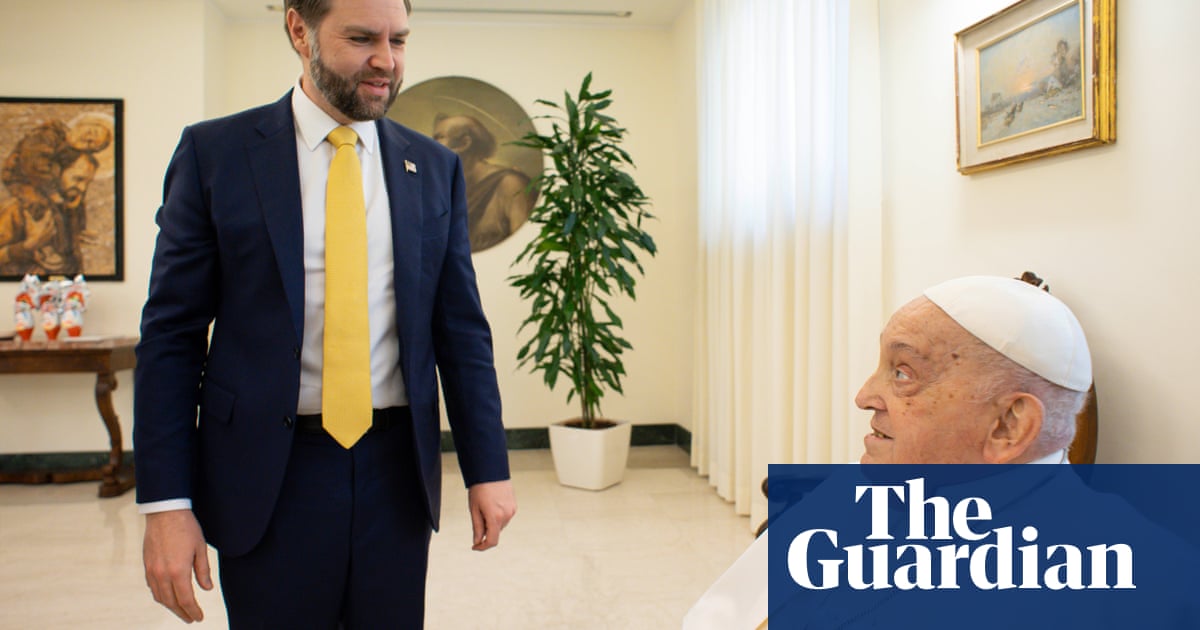Pope Francis and JD Vance, who have disagreed very publicly over the Trump administration’s attitude to immigration and its migrant deportation plans, met briefly in Rome on Sunday to exchange Easter greetings.
The meeting came a day after the US vice-president, who converted to Roman Catholicism in 2019, sat down with senior Vatican officials and had“an exchange of opinions”over international conflicts and immigration.
Francis, who is recovering from a near-fatal bout of pneumonia, received Vance in one of the reception rooms of theVaticanhotel where he lives. The 88-year-old pontiff offered the vice-president three big chocolate Easter eggs for Vance’s three young children, who did not attend, as well as a Vatican tie and rosaries.“I know you have not been feeling great, but it’s good to see you in better health,” Vance told the pope. “Thank you for seeing me.”The Vatican said the two men met for a few minutes at the Domus Santa Marta “to exchange Easter greetings”. Vance’s office confirmed that they met, but provided no further details. In all, Vance’s motorcade was on Vatican territory for 17 minutes.Vance later joined his family for Easter mass at St Paul Outside the Walls, one of the four pontifical basilicas in Rome. The Vances visited the tomb of the apostle St Paul that is said to be located there.
Vance and the leader of the world’s 1.4bn Roman Catholics differ sharply when it comes to the issue of migration. In February, Francis – who has made caring for migrants a hallmark of his papacy – warned that the Trump administration’s mass deportation efforts and other policies cracking down on immigration, weredriving a “major crisis”that “damages the dignity of men and women”.
In a letter to US bishops, Francis also appeared to respond to Vance directly for having claimed that Catholic doctrine justified such policies.Vance, who acknowledged the pontiff’s criticism, has said he would continue to defend his views. While he did not address the issue specifically during an appearance at the National Catholic Prayer Breakfast in Washington in February, Vance called himself a “baby Catholic” and acknowledged there were “things about the faith that I don’t know”.On Saturday, Vance met the Vatican secretary of state, Cardinal Pietro Parolin, and its foreign minister, Archbishop Paul Gallagher.Vance’s office said he and Parolin “discussed their shared religious faith,Catholicismin the United States, the plight of persecuted Christian communities around the world, and President Trump’s commitment to restoring world peace”.The Vatican, for its part, said there had been an “exchange of opinions” including over migrants, refugees and conflicts.
“Finally, hope was expressed for serene collaboration between the state and the Catholic church in the United States, whose valuable service to the most vulnerable people was acknowledged,” the Vatican added in a statement.
The reference to “serene collaboration” appeared to refer to Vance’s accusation that the US conference of Catholic bishops was resettling “illegal immigrants” in order to obtain federal funding. Top US cardinals have pushed back strongly against the claim.
In thetraditionalUrbi et Orbimessage, which was read out on his behalf on Easter Sunday, Francis called on world leaders to help those in need and to work towards peace.
“I appeal to all those in positions of political responsibility in our world not to yield to the logic of fear which only leads to isolation from others, but rather to use the resources available to help the needy, to fight hunger and to encourage initiatives that promote development,” he said. “These are the ‘weapons’ of peace: weapons that build the future, instead of sowing seeds of death!”The Associated Press contributed to this report
